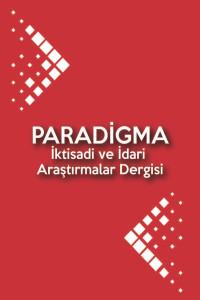AN ORGANIZATION STRUCTURE SUGGESTION OF NATIONAL DESTINATION MANAGEMENT ORGANIZATIONS FOR TURKEY
Çok sayıda paydaşa sahip olan destinasyonların, turizm faaliyetlerinin koordine edilmesi oldukça önemlidir. Türkiye’de, turizm destinasyonlarındaki paydaşlar arasında var olan işbirliği ve iletişim eksikliği, sorunlara neden olduğundan destinasyon yönetim örgütlerine gerek duyulmaktadır. Destinasyon yönetim örgütleri konusunda, Türkiye’de teorik alanda çalışmalar yapılmaya başlansa da pratikte henüz uygulamaya geçilmemiştir. Bu çalışmada, Türkiye için Ulusal Destinasyon Yönetim Örgütü’nün nasıl bir organizasyon yapısına sahip olması gerektiğinin tespiti amaçlanmaktadır. Türkiye’de turizm sektöründe faaliyet gösteren kamu ve özel sektör kuruluşları ile turizm alanında araştırma yapan akademisyenler ve turizm sektöründen hizmet alan ziyaretçiler arasından alanında uzman 39 kişinin görüşleri bir araya getirilmiştir. Alternatiflerin, kriterlere göre önem dereceleri Mintzberg’in Beş Organizasyon Yapısının Tasarım Parametrelerinin Ölçüleri dikkate alınarak, kriterlerin önem dereceleri ise uzman görüşü alınarak belirlenmiştir. Analitik Hiyerarşi Süreci (AHS) yönetimi kullanılarak Mintzberg’in belirlemiş olduğu 5 temel organizasyon türü arasından seçim yapılmıştır. Türkiye için en uygun Ulusal Destinasyon Yönetim Örgütü organizasyon yapısının Profesyonel Bürokrasi türünde olması gerektiği tespit edilmiştir.
Anahtar Kelimeler:
Destinasyon Yönetim Örgütü (DYÖ), Mintzberg’in Organizasyon Yapıları, Analitik Hiyerarşi Süreci (AHS)
AN ORGANIZATION STRUCTURE SUGGESTION OF NATIONAL DESTINATION MANAGEMENT ORGANIZATIONS FOR TURKEY
Coordination of tourism activities with a large number of stakeholders is very important. The lack of cooperation and communication between stakeholders in tourism destinations in Turkey is causing problems. Therefore, destination management organizations are needed. Even though the theoretical field studies in the field of destination management organizations have begun, it has not been implemented yet. In this study, it is aimed to determine what kind of organization structure the National Destination Management Organization should have for Turkey. The opinions were gathered together from 39 experts in the field among public and private sector organizations operating in the tourism sector in Turkey, academicians conducting research in the field of tourism, and tourists from the tourism sector. The importance ratios of the alternatives according to the criteria were determined by taking into account the Mintzberg's Five Organizational Structure Design Parameters metrics. The importance ratios of the criteria were also determined by taking the expert opinion. Using the Analytical Hierarchy Process (AHS) method, a selection was made from five basic organizational types that Mintzberg identified. It has been determined that the most appropriate structure of National Destination Management Organization for Turkey should be Professional Bureaucracy type.
Keywords:
Destination Management Organization (DMO), Mintzberg Organization Structure, Analytical Hierarchy Process (AHP),
___
- Akkoyunlu, L. (2008). Mintzberg’in Organizasyon Yapılarının Tanımlanmasında Bulanık Mantığın Kullanılması, Bir Model Önerisi ve Modelin Uygulanmasına İlişkin Bir Araştırma. (Yayınlanmamış doktora tezi). İstanbul Üniversitesi/Sosyal Bilimler Enstitüsü, İstanbul.
- Baker, M.J., Cameron, E. (2008). Critical Success Factors in Destination Marketing. Tourism and Hospitality Research, 8, 79-97.
- Blumberg, K. (2005). Tourism Destination Marketing –A Tool for Destination Management? A Case Study from Nelson/Tasman Region, New Zealand. Asia Pacific Journal of Tourism Research, 10 (1), 45-57.
- Bornhorst, T., Brent Ritchie, J.R., Sheehan, L. (2010). Determinants of tourism success for DMOs & destinations: An empirical examination of stakeholders’ perspectives. Tourism Management, 31, 572-589.
- Buhalis, D. (2000). Marketing the competitive destination of the future. Tourism Management, 21, 97–116.
- Çırpan, H, Koyuncu, M. (1998). İşletme Kültürünün Alt Kademe Yöneticileri Üzerindeki Etkisi: Bir Örnek Olay Çalışması. Öneri, 9 (2), 223-230.
- Elbe, J., Hallen, L., Axelsson, B. (2009). The destination-management organization and the integrative destination-marketing process. International Journal of Tourism Research, 11, 283-296.
- Gartrell, R. (1994). Strategic partnerships. In Destination marketing for convention and visitor bureaus, 230–232.
- Gretzel, U., Fesenmaier, D.R., Formica, S., O’Leary, J.T. (2006). Searching for The Future: Challenges Faced by Destination Marketing Organizations. Journal of Travel Research, 45, 116-126.
- Harrıll, R. (2005). Fundamental of Destination Management and Marketing. Destination Marketing Association International.
- Magas, D. (2010). Why The Destination Management Organization? Tourism & Hospitalty Management, 1041-1047.
- Mıntzberg, H., Quinn, J.B., Voyer, J. (1995). The Strategy Process. New Jersey: Prentice Hall,
- Mıntzberg, H. (1979). The Structuring of Organizations. Prentice Hall.
- Mıntzberg, H. (1980). Structure’s in 5’s: A Synthesis of the Research Organization Design. Management Science, 26 (3), 322-341.
- Mıntzberg, H. (1993), Structure in Fives Designing Effective Organization. Prentice Hall.
- Murphy, P., Pritchard, M.P., Smith, B. (2000). The destination product and its impact on traveller perceptions. Tourism Management, 21, 43-52.
- Önder, G., Önder, E. (2015). Analitik Hiyerarşi Süreci. Yıldırım, B.F., Önder E. (Eds.), Çok Kriterli Karar Verme Yöntemleri içinde (s. 21-74). Bursa: Dora.
- Özden, Ü.H., (2008). Analitik Hiyerarşi Yöntemi İle İlkokul Seçimi. Marmara Üniversitesi İ.İ.B.F., 24 (1), 299-320.
- Pike, S. (2004). Destination Marketing Organizations. Elsevier.
- Pike, S. (2008). Destination Marketing: An Integrated Marketing Communication Approach. Elsevier.
- Pike, S., & Page, S. J. (2014). Destination Marketing Organizations and destination marketing: A narrative analysis of the literature. Tourism management, 41, 202-227.
- Sainaghi, R. (2006). From contents to processes: Versus a dynamic destination management model (DDMM). Tourism Management, 27, 1053–1063.
- Sheehan, L. R., Brent Ritchie, J.R. (2005). Destination Stakeholders: Exploring Identity and Salience. Annals of Tourism Research, 32 (3), 711–734.
- Shirazi, S.F.M., Som, A.P.M. (2011). Destination Management and Relationship Marketing: Two Major Factors to Achieve Competitive Advantage. Journal of Relationship Marketing, 10, 76-87.
- Yavuz, M.C., Karadağ, S.F. (2009). Ulusal Turizm Tanıtımı ve Pazarlama Yönetimi Örgütlenmesi: Türkiye İçin Bir Model Önerisi. İstanbul Üniversitesi İletişim Fakültesi, 36, 113-130.
- Yılmaz, E. (1999). Analitik Hiyerarşi Süreci Kullanılarak Çok Kriterli Karar Verme Problemlerinin Çözümü. DOA, 5, 95-122.
- Yayın Aralığı: Yılda 2 Sayı
- Başlangıç: 2022
- Yayıncı: Gümüşhane Üniversitesi
Sayıdaki Diğer Makaleler
ELEKTRONİK AĞIZDAN AĞIZA İLETİŞİM DAVRANIŞLARININ SATIN ALMA NİYETİ ÜZERİNE ETKİSİ: FACEBOOK ÖRNEĞİ
BANKALARIN YÖNETİM KURULLARINDAKİ CİNSİYET ÇEŞİTLİLİĞİ VE FİNANSAL PERFORMANS İLİŞKİSİ
MAHALLE YÖNETİMİ VE MAHALLE MUHTARLARININ PROFİLİ: TRABZON ORTAHİSAR ÖRNEĞİ
Hasan Mahmut KALKIŞIM, Nihat YILMAZ
KAMU HARCAMALARI VE DIŞ BORÇLANMA İLİŞKİSİ: TÜRKİYE İÇİN EKONOMETRİK BİR ANALİZ
Mehtap Tarhan BÖLÜKBAŞ, Aslı YENİPAZARLI, Mehmet BÖLÜKBAŞ
EFFECTS OF GUERRILLA MARKETING ON BRAND AWARENESS AND CONSUMERS’ PURCHASE INTENTION
İŞSİZLİKLE FAİZİN TÜRKİYE'DE EKONOMİK BÜYÜMEYE ETKİSİ :1980-2016
